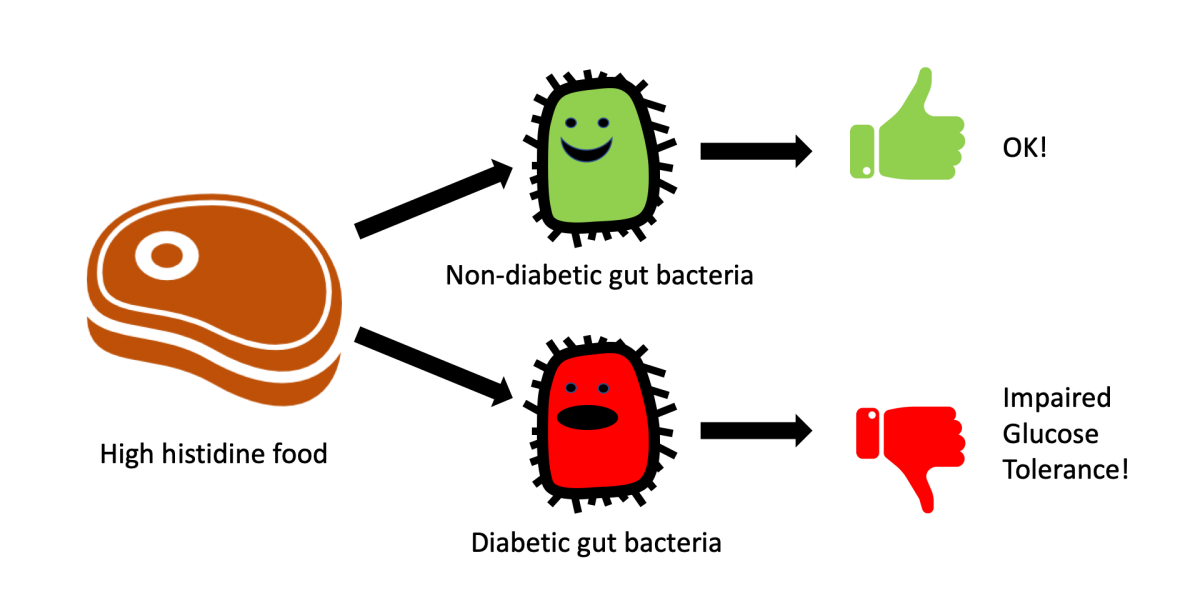This past week, a new study was published in the November 1 issue of Cell further investigating a role of gut bacteria and amino acid metabolism and its role in impairing insulin sensitivity. The particular branch-chained amino acid (BCAA) under study was histidine, and how the gut bacteria process it differently in diabetic versus non-diabetic individuals.
In diabetics, gut bacteria process histidine into a specific metabolite called imidazole propionate at much higher concentrations, and this metabolite is believed to impair insulin signaling. Here’s a picture from the study that describes the mechanism:

To me, what is really significant about this study is the linkage to the gut bacteria.
In the past, doctors and scientists used to blame high protein and red meat for reducing insulin sensitivity. After all, high histidine foods include beef, lamb, cheese, pork, chicken and other high protein foods. Some examples of studies linking high protein diets to insulin resistance include:
- A 2009 study out of Duke expanded upon this hypothesis that high levels of protein coupled with high levels of fat (“the Western diet”) led to reductions in insulin sensitivity in animal studies.
- A 2016 study out of New Zealand also took a closer look at high protein / high fiber diets and their effect on insulin sensitivity, taking fat out of the equation. Taking into account weight loss differences, the study observed reduction in insulin sensitivity in obese study participants with high protein, compared to high carbohydrate, low fat diets.
- A study published in the June issue of the Journal of Hepatology drew an association of insulin resistance with consumption of red meat and high heat cooking methods. Here is its “lay summary:”
High red and processed meat consumption is related to several diseases. In addition, cooking meat at high temperatures for a long duration forms heterocyclic amines, which have harmful health effects. Non-alcoholic fatty liver disease is a significant public health burden and its formation is strongly related to insulin resistance. In this study, both were found to be more frequent in people who consume relatively high quantities of red and processed meat. In addition, a high intake of heterocyclic amines was associated with insulin resistance.
The natural reaction many reading these studies (which I think are valid, by the way) would be to figure out how to reduce protein intake to improve insulin sensitivity. Even with this latest study, if histidine causes increased production of a harmful metabolite in diabetics, why not reduce histidine intake by reducing protein intake? Not so fast.
I personally believe that this most recent study about the gut bacteria metabolizing histidine differently in diabetics from non-diabetics helps fill in a missing gap. All around us there are exceptions to people who live on high protein / high meat diets that do not have diabetes or heart disease. Just google “Inuit paradox” or “French paradox” and you’ll get lots of hypotheses why this may be the case, ranging from the types of fats in seals and walruses to drinking wine. All of this may be valid, but there is a lack of discussion about gut bacteria.
If you haven’t already, see my previous blog post about gut bacteria and Type II diabetes. The association between dysbiosis (an imbalance in the gut bacteria) and diabetes has been shown to be strong, and there are numerous studies demonstrating that fasting can positively affect the gut microbiome.
Personally, I believe that repairing the gut microbiome, returning the histidine metabolism of diabetics to be more like non-diabetics, may be a more promising step toward addressing the root causes of insulin resistance, rather than simply trying to reducing protein intake without fixing the underlying problem.

Leave a Reply